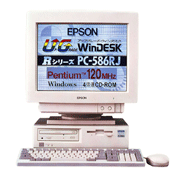Seiko Epson announced the PC-586RJ in May 1995. This high-performance machine came with a 120-MHz Pentium processor that could handle the evolution in operating systems and application software brought on by the popularity of Windows 3.1 and the advent of multimedia computing. Because of its computing power, the PC-586RJ could even function as an engineering CAD machine. For graphics work, this model was equipped with a Vision 964 high-speed 64-bit Windows accelerator chip, which supported multiple resolutions and full color. As a result, the computer could quickly render high-resolution graphics at 640×480, 1024×768, 1280×1024, and other resolutions.
The PC-586RJ was standard equipped with a 256-kilobyte secondary cache, in addition to the 16-kilobyte internal CPU cache, to harness the full performance of the Pentium processor. The standard configuration came with 8 megabytes of main memory, which was expandable up to 192 megabytes.


